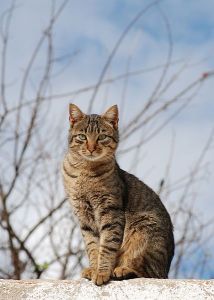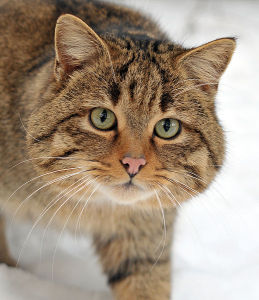This is an article dear to my heart.
One of these is an Eastern European wildcat (Felis Silvestris) and the other is a common house cat.


Any guesses?
Cats have only been domesticated (for varying values of “domesticated”) for about 10,000 years. Dogs, on the other hand, have been domesticated for about 30,000 years. Even some of the most exotic cat breeds are barely different from the wildcat cousins.
There’s been some fascinating research on foxes in Russia for the past 50 odd years. The researchers focused on breeding the most friendly/least fearful foxes. They approached the young foxes twice in their growth. The foxes that did not cower from or growl at the researchers in those two trials got to breed. Within several generations, the foxes were very approachable. They also had droopy ears and their fur color changed more toward brown.
That seems to indicate a genetic component to domestication. All the behaviors that we associate with domesticated dogs are the results of genetic changes to the ancestral species.
The same thing has happened in cats. but, cats being obviously cooler and more important, have had their genomes sequenced and a comparative analysis done. Just the base research in this is really cool and I’ll share some highlights.
The researchers identified six genes with positive selection pressure for hearing. They know that this is the case because mutations in these genes have been identified as causing deafness and other hearing disorders. Other genes were identified as having positive selection pressure for eyesight. As these genes, in humans, result in various visual malfunctions. In one case, a mutation in the gene results in night-blindness. Not a useful trait for a nocturnal carnivore.
I need to point out something here. Positive selection, in evolution speak, is the process of promoting/spreading beneficial alleles. Negative selection is the process of removing harmful or detrimental alleles. Any mutations that increased an ancestral felid’s auditory or visual acuity would be beneficial and give that animal an advantage. That animal would be more successful and thus tend to spread that allele around, increasing the percentage of that allele in the next generation. Similarly, a negative selection would be a felid that is born with a mutation that decreases auditory or visual acuity. This would render them less able to hunt/survive and that allele would rapidly be eliminated from the gene pool.
This isn’t just a guess. The researchers compared the genomes of several felids and a dog to see the relative increase in functional and non-functional genes. Not surprising domestic cats have more non-functional genes that tigers. Being domesticated has it’s advantages. Even some otherwise very harmful mutations can increase an animal’s survival when humans find it attractive (thinking of pugs and Persians here).
That’s pretty cool in and of itself, but the research keeps coming.
I didn’t know this one. Cats aren’t affect the plasma lipid concentrations that causes humans to have heart disease and plaque build-up. There are multiple genes that regulate triglyceride levels and metabolize fatty acids, essential for a hyper-carnivore.
The researchers further identified gene duplication and gene loss events by, again, comparing dogs, tigers, and cats. They found that dogs gave many more olfactory genes and fewer visual genes. While the cats have the opposite. Cats are visual and auditory hunters, while dogs are scent hunters.
The researchers predicted that there would be minimal effects on the domestic cat genome due to the relatively recent “domestication” and the very close morphological relationship between domestic cats and their nearest wild relatives. And this is where the paper starts to get really impressive. They did whole genome compares between four wildcats of two different breeds and 22 domestic cats of from six distinct breeds[1]. This huge data pool allowed them to correct for genetic drift.
The researchers found that the differences between wild cats and domestic cats was limited to 12 genes, most of which are related to neural processes. Specifically, they note that these genes are related to behavior and context clues for reward. This supports evidence from the Russian silver fox experiments and something called the Domestication Syndrome Hypothesis (PDF).
This is the first I’ve heard about that, but it’s fascinating reading. The hypothesis is that all of the physical and mental traits that appear due to domestication are the result (directly of indirectly) of changes to the neural crest cells during embryonic development.
All of the traits described in dogs (and now cats) have in common is that they are linked to or derived from neural crest cells. These are stem cells in vertebrates that both control how other systems develop (skull and brain tissue, adrenal glands, and teeth) and give rise to a variety of parts (jaws, larynx, ears, etc).
Before this hypothesis, many thought that domestication was purely a removal of fear through changes in the adrenal glands. But the neural crest cell hypothesis improves on that by explaining how the adrenals are changed and how other morphological and behavioral factors are changed as well.
Taken together, we propose that changes in these neural crest-related genes underlie the evolution of tameness during cat domestication, in agreement with analyses of other domesticated genomes. (page 4)
Then, just because the authors are bloody awesome, they identified a previously unknown gene that causes Birman cats to have gloves or boots… that’s the white part on the paws.
They identified the KIT gene on chromosome B1 as having a pair of mutations. Every Birman in a sample of 150 Birman cats with gloves and 729 non-Birman cats confirmed that Birmans are all homozygous for both mutations. Plus, all out-crossed Birman offspring with no-gloves were carriers.
So, the Birman cat gloves are a recessive allele.
I am really impressed with this work. First, it’s on cats. Second it does really potent genetic analyses into the evolution of cats. Third, it provides supporting evidence for a hypothesis[2]. Fourth, just as an aside, they identified an allele that could potentially help breeders and veterinarians.
Epic win!
________________________
1 in case you are curious, they were the Egyptian Mau, Maine Coon, Norwegian Forest Cat, Japanese Bob, Birman, and Turkish Van.
2 Note to creationists… this is how you do it.
3 Final note. The top picture is a domestic cat and the bottom picture is a European Wildcat.
